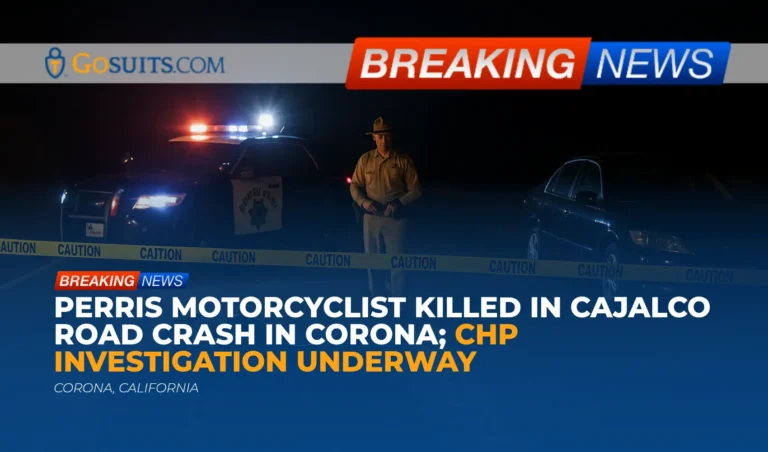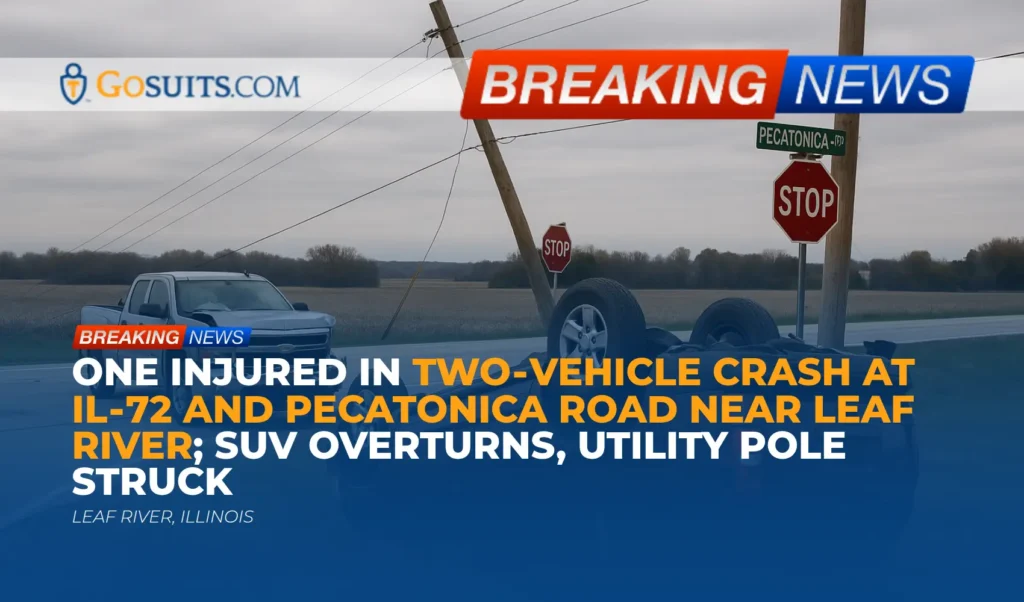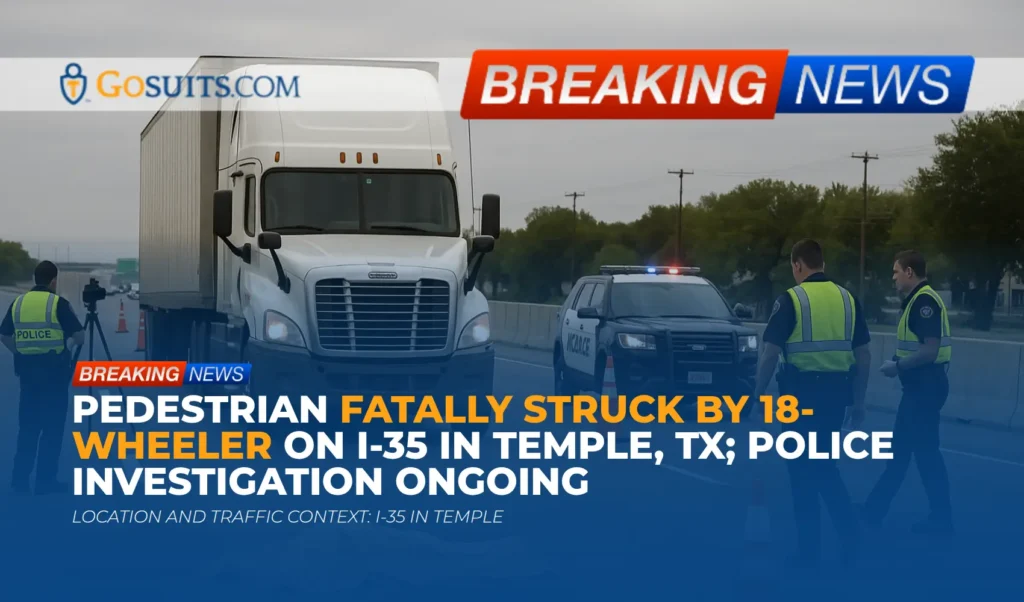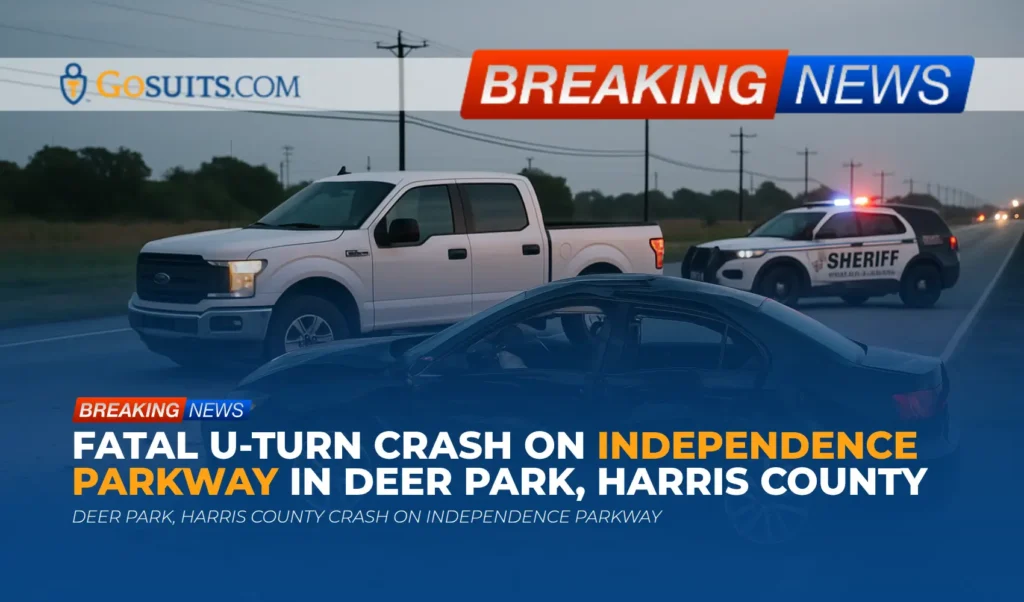- What We Know About the Cajalco Road Collision in Corona
- Location, Timing, and Road Closure Details
- Agencies Involved and How Investigations Typically Proceed
- Immediate Information and Records: Who to Contact
- Safety and Legal Context for Nighttime Motorcycle Crashes
- Potential Civil Liability and Rights After a Fatal Two-Vehicle Crash in California
- Evidence to Preserve and Why Timing Matters
- How Insurance Companies Typically Approach These Claims
- Step-by-Step: Navigating Insurance After a Fatal Crash
- Community Resources and Support
- Time-Sensitive Next Steps: Why Acting Promptly Matters
- Commentary from Gosuits Corona, California Personal Injury Attorney
What We Know About the Cajalco Road Collision in Corona
According to information released by local authorities, a fatal two-vehicle collision occurred on Sunday evening in Corona, California. The Riverside County Sheriff’s Department Coroner’s Bureau identified the motorcyclist as a 48-year-old resident of Perris. The collision involved a motorcycle and a black sedan. First reports indicate that one of the vehicles left the roadway and traveled about 300 feet down a canyon, though it was not immediately clear which vehicle went off the road. The motorcyclist died at the scene shortly before 9 p.m. following the crash reported around 8:45 p.m. The decedent’s identity was released after notification of next of kin.
In situations like this, the community often has many questions: what happened on the roadway, how fault will be evaluated, and what steps family members can take to gather official records. The information below is intended to help families and community members understand the process, typical investigative steps, and the civil legal context that can follow a serious or fatal traffic collision.
Location, Timing, and Road Closure Details
Authorities reported the crash location on Cajalco Road, approximately two miles east of Eagle Canyon Road. After the collision, Cajalco Road was temporarily closed between Temescal Canyon Road and La Sierra Avenue to allow emergency responders and investigators to work safely. Nighttime conditions were present; visibility and lighting often factor into analysis in similar incidents.
Even without immediate fault determinations, the closure and the reported distance a vehicle traveled off the roadway suggest a significant crash force and complex scene. Investigators typically document skid marks, scrape patterns, final rest positions, debris fields, vehicle damage profiles, and any environmental factors like lighting, signage, and road edge condition.
Agencies Involved and How Investigations Typically Proceed
The California Highway Patrol (CHP) generally leads investigations for traffic incidents on state or county roadways outside city police jurisdictions. In this event, CHP handled the crash report. The Riverside County Sheriff-Coroner’s Bureau manages decedent identification and cause-of-death determination.
Standard investigative steps in a fatal collision often include:
- Scene documentation with measurements, photographs, total station mapping, or 3D scanning when available.
- Witness interviews to capture observations about speeds, lane changes, lighting, signaling, and the sequence of events.
- Vehicle inspections assessing braking systems, tire condition, lighting, and damage patterns.
- Event Data Recorder (EDR) downloads from equipped passenger vehicles, which can show speed, throttle, and braking inputs moments before impact. NHTSA provides technical guidance on EDRs and regulations governing them. See NHTSA EDR overview.
- Toxicology testing as part of the coroner’s work when appropriate.
- Roadway and environmental assessment for lighting, signage visibility, lane markings, edge drop-offs, guardrails, and other safety features.
These steps can take weeks. Families often do not receive immediate answers about causation or fault, and that can feel difficult and frustrating. It is appropriate to request copies of official reports once available and to preserve any related evidence that may exist outside the official file.
Immediate Information and Records: Who to Contact
Families and representatives commonly need several categories of records after a fatal collision. The following list outlines what these are and how they are generally obtained. Where statewide resources exist on government or academic sites, they are linked below.
Collision Reports (CHP)
CHP collision reports are requested using the CHP 190 form through the local CHP Area office that investigated the crash. The form and instructions are available at the California Highway Patrol website: CHP 190 Collision Report Request. Applicants typically need the date, location, and party names to process the request.
Coroner’s Records and Autopsy Reports
County Coroner’s or Medical Examiner’s offices manage autopsy reports, cause of death, and certain related records. In Riverside County, the Sheriff-Coroner’s Bureau provides those services. Procedures and timelines vary by county. California’s Government Code outlines coroner duties and reporting framework; families can consult state law for general guidance while following their county’s procedures. For example, the California Government Code provides statutory guidance regarding coroner investigations and records management. See Government Code provisions addressing coroner duties and reporting processes via the official code repository at leginfo.legislature.ca.gov.
When reaching out to a county coroner’s office, be prepared with the decedent’s full name, date of death, and case number if available. Staff can advise on availability and any next-of-kin authorization requirements.
Death Certificates
Certified death certificates can be requested through the California Department of Public Health’s Vital Records program or through the county clerk-recorder. State-level guidance and request forms are maintained here: California Department of Public Health: Vital Records.
Towed Vehicle and Personal Effects
Vehicles involved in collisions are often towed to a rotation tow yard designated by the investigating agency. The investigating agency or dispatch can typically confirm the storage location. Personal effects, if retained as part of the investigation, may be released when allowable; contacting the investigating officer or property/evidence unit is the usual path.
Safety and Legal Context for Nighttime Motorcycle Crashes
Nighttime riding imposes unique challenges: reduced visibility, glare from oncoming traffic, and limited sight distance, especially on canyon or rural roads with curves and elevation changes. The California DMV’s Motorcycle Handbook offers statewide safety guidance on lane positioning, scanning, and strategies for riding in low-light conditions. See the DMV’s resource here: DMV Motorcycle Handbook.
At a high level, collision analysis in motorcycle-sedan crashes often considers whether each driver kept a proper lookout, maintained a safe speed for conditions, used appropriate lane positioning, and signaled intentions. Investigators also assess roadway design and traffic control devices.
National data underscore the risks riders face. Federal highway safety data indicate motorcyclists are overrepresented in fatal crashes relative to their share of roadway travel. NHTSA maintains up-to-date motorcycle safety data and publications on risk factors and protective strategies: NHTSA: Motorcycles.
Potential Civil Liability and Rights After a Fatal Two-Vehicle Crash in California
While every case turns on specific facts, several civil law principles frequently arise after a fatal roadway collision in California. The information below is educational and general; individual circumstances vary.

Negligence and Comparative Fault
In California, liability for a motor vehicle collision is typically grounded in negligence. If a driver failed to use reasonable care and that failure caused harm, they may be held responsible for damages. California follows the doctrine of comparative negligence, which permits fault to be apportioned between parties. This principle was recognized by the California Supreme Court in Li v. Yellow Cab Co., allowing responsibility to be shared proportionally based on each party’s contribution to the crash. See the opinion overview hosted by Stanford Law School: Li v. Yellow Cab Co..
Wrongful Death Claims
California permits certain relatives and dependents to bring a wrongful death action following a fatal incident. Eligibility is set by statute. See California Code of Civil Procedure section 377.60 at the state’s official code site: CCP § 377.60.
Time limits are important. Many wrongful death actions based on negligence must be filed within two years of the date of death. See CCP § 335.1. Some claims may have shorter deadlines, particularly when a public entity may be involved.
Survival Actions
Separate from wrongful death, a survival action may allow the decedent’s estate to pursue certain claims the decedent could have brought had they survived. See CCP § 377.34 for the statutory framework. The availability and scope of survival damages depend on the facts and timing.
Public Entity Liability for Roadway Conditions
When the facts indicate a potential unsafe road condition contributed to a collision (for example, inadequate signage, missing guardrails, or dangerous drop-offs without protection), California law provides a pathway for claims against public entities under specific circumstances. See Government Code section 835 regarding liability for dangerous conditions of public property: Gov. Code § 835.
Claims against public entities have special presentment deadlines. A claim generally must be presented within six months of the incident for personal injury or death, with limited exceptions. See Government Code section 911.2: Gov. Code § 911.2.
Insurance Coverages That May Apply
Several insurance coverages can be relevant after a fatal traffic collision:
- At-fault driver’s liability insurance for bodily injury and property damage, subject to policy limits and exclusions.
- Uninsured/Underinsured Motorist (UM/UIM) coverage on the motorcyclist’s policy or a household policy, when the at-fault driver lacks adequate insurance.
- Medical payments (MedPay) coverage, if available, which may help with certain immediate expenses regardless of fault, depending on policy terms.
- Potential public entity coverage if a viable claim exists under the Government Claims Act.
Understanding how these coverages interact, including offsets, stacking rules, and subrogation rights, is important before communicating extensively with insurers.
Evidence to Preserve and Why Timing Matters
Preserving evidence early can be pivotal in understanding what happened and in protecting rights. Consider the following items and steps:
- Vehicles and components: Preserve or document the motorcycle and sedan, including lighting systems, brake components, tire condition, and any aftermarket parts. Avoid repairs or salvage before a thorough inspection.
- Event Data Recorder (EDR): Modern passenger vehicles often store pre-crash data. Access usually requires owner consent, a court order, or statutory permission. See NHTSA guidance on EDR.
- Rider gear: Helmets, jackets, gloves, boots can show impact points, abrasion patterns, and potential product issues. Preserve these items unaltered.
- Onboard or nearby video: Motorcycle or vehicle dashcams, adjacent businesses, residential security cameras, and public agency cameras may capture the incident. Footage is often overwritten quickly.
- Witness information: Names, contact details, and contemporaneous notes are valuable before memories fade.
- Cell phone records and telematics: Location data or ride-tracking apps can help reconstruct timelines.
- Roadway conditions: Prompt site inspections for lighting, signage, lane markings, shoulder width, guardrail presence, and any construction activity can matter, especially on roads with canyon drop-offs.
Independent experts, such as accident reconstructionists and human factors analysts, are often engaged in complex collisions to model speeds, sight lines, and reaction times.
How Insurance Companies Typically Approach These Claims
After a fatal crash, insurers for involved drivers begin investigating promptly. Common insurer actions include recorded statements, scene photography, vehicle inspections, and requests for medical or coroner records. Adjusters evaluate liability and damages against policy terms and limits.
It is important to remember that any statements made to insurers can be used to evaluate and potentially minimize claims. Before giving a recorded statement, providing authorizations, or discussing settlement, it is prudent to speak with a qualified attorney for a free consultation to understand rights and obligations.
Step-by-Step: Navigating Insurance After a Fatal Crash
The sequence below is a general framework used in many California cases. Timelines and specific steps may vary with the facts:
- 1) Obtain official reports: Request the CHP collision report using CHP 190. Follow up later for any supplemental reports. Keep the incident number handy when communicating with agencies.
- 2) Secure documentation: Request death certificates via CDPH Vital Records and inquire with the county coroner regarding autopsy reports when available.
- 3) Preserve evidence early: Place tow yards, insurers, and any storage facilities on written notice to preserve vehicles and components. Request that no alterations be made without inspection.
- 4) Identify all insurance coverages: This may include policies for the motorcyclist, any household UM/UIM coverage, and the other driver’s liability policy. Carefully review policy declarations and exclusions.
- 5) Consider potential public entity involvement: If roadway conditions appear to be a factor, calendar the six-month presentment deadline under Gov. Code § 911.2 while facts are investigated.
- 6) Approach insurer communications cautiously: Before contacting any insurer or giving statements, consult an attorney. What is said early can be used later in liability and damages assessments.
- 7) Track expenses and losses: Keep organized records of funeral and memorial expenses, loss-related costs, and documentation related to the decedent’s earnings and financial contributions to dependents.
- 8) Monitor timelines: Be mindful of the general two-year statute of limitations for wrongful death in California, see CCP § 335.1, and the earlier deadlines that can apply in public entity matters.

Community Resources and Support
Grief and logistical tasks arrive at the same time after a sudden loss, and that is a heavy burden. The following statewide and educational resources may be helpful:
- California DMV Motorcycle Handbook: Safety considerations for riders and drivers sharing the road. DMV Motorcycle Handbook
- UC Berkeley SafeTREC TIMS: A publicly accessible tool for viewing statewide collision data to understand broader safety patterns. TIMS at UC Berkeley SafeTREC
- NHTSA Motorcycle Safety: National data and safety strategies. NHTSA: Motorcycles
Local support groups, faith communities, and counseling services can also help families process grief while navigating practical steps.
Time-Sensitive Next Steps: Why Acting Promptly Matters
When a fatal collision occurs, a few time-sensitive actions can materially affect the clarity of the investigation and the preservation of rights:
- Prompt records requests help establish the baseline facts and keep important dates on the radar, especially deadlines that can arrive faster than expected.
- Early evidence preservation protects the ability to understand what happened, including vehicle data, roadway conditions, and video that may be lost if not requested quickly.
- Careful insurer communications reduce the risk of misunderstandings. A preliminary consultation with an attorney before talking to insurers can help avoid common pitfalls.
- Calendar key deadlines such as the two-year wrongful death period and the six-month government claim period when a public entity may be involved.
- Organize documents like funeral receipts, employer letters, and benefits information; contemporaneous documentation is often more reliable.
Taking these steps early helps ensure that the eventual decisions are informed by the fullest, most accurate record possible.
Commentary from Gosuits Corona, California Personal Injury Attorney
First and foremost, our thoughts are with the family, friends, and community affected by this tragic loss. The information above is offered for general educational purposes. In the wake of a sudden, fatal crash, it is natural to seek clear answers. That clarity often takes time as investigators examine the scene, vehicles, and witness accounts.
From a civil perspective, a two-vehicle collision on a canyon-adjacent roadway raises several familiar questions: visibility and lighting at night, each driver’s lookout and speed, and whether roadway features like guardrails or signage were adequate for conditions. The report that a vehicle traveled approximately 300 feet down a canyon underscores the severity of the incident. Determining why this occurred often requires a careful, methodical review of the roadway environment, vehicle data, and human factors.
In our experience, insurers move quickly, and their goals in early communications can differ from the needs of a grieving family. Adjusters may request recorded statements or broad medical and records authorizations soon after a loss. Without full context, statements made early can be used later to minimize responsibility or damages. A free consultation with a seasoned attorney before speaking with insurance companies can help ensure that rights are understood and protected, and that critical evidence is preserved while it is still available.
It is also important to remember that California recognizes comparative fault, meaning responsibility can be shared and allocated between parties based on the facts. That makes thorough investigation vital. If there are indications that roadway conditions contributed to the crash, the timeline for claims against public entities is short, and early action is especially important to avoid missing crucial deadlines.
Families should know they do not need to navigate these processes alone. Careful, informed steps taken in the first days and weeks can make a meaningful difference in achieving clarity about what happened and in protecting the rights provided under California law.






